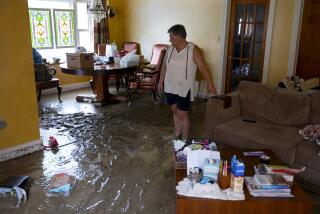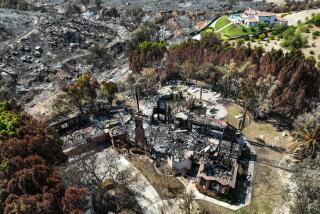Hurricane Irene leaves behind a bill for taxpayers
Even if you don’t live on the storm-ravaged East Coast, Hurricane Irene is going to cost you.
The storm left behind an enormous swath of destruction, with early estimates pegging the damage between $2 billion and $7 billion. And taxpayers will be left footing much of the rebuilding bill.
That higher-than-necessary bill can be blamed on a lack of flood insurance coverage in the Northeast, and a flawed federal insurance program that’s billions of dollars in debt.
Photos: In the path of the storm
Vermont illustrates the first problem. The state faces some of the worst flooding in its history and — according to one analysis of 2010 flood insurance data — could have a scant 3,600 federal flood insurance policies. That means people looking to rebuild will rely on taxpayer-funded payouts from the Federal Emergency Management Agency and subsidized loans from the Small Business Administration.
“The bottom line is, taxpayers are going to be left holding the bag due to the number of folks in the Eastern Seaboard that did not have flood insurance for this catastrophic event,” said Mike Chaney, an insurance commissioner for Mississippi who has called for reforms to the troubled National Flood Insurance Program.
Those loans and payouts are unlikely to cover the cost of reconstruction as fully as a federal insurance policy would have, experts say.
But even for the states along Irene’s path, such as New York and New Jersey, that have hundreds of thousands of policies, the damages paid out from the National Flood Insurance Program’s coffers may still ultimately come from taxpayers — in the form of a bailout, experts said.
The National Flood Insurance Program is the largest flood insurance provider in the nation, with $1.2 trillion in covered property. The program began in 1968 as a way to provide flood insurance where none privately existed and to shield taxpayers from paying for policy owners in flood-prone areas.
But today, analysts say, the program is more than $17 billion in debt, is plagued by management problems and doesn’t cover enough people.
If the program borrows from the Treasury to cover payouts for Hurricane Irene, it will deepen the program’s need for a bailout, meaning U.S. taxpayers will bear a greater brunt of the storm’s damage on the Eastern Seaboard than they would have if the program weren’t underwater, so to speak.
The flood program is also due to expire at the end of September, and insurance and real estate lobbyists have said that a long-term congressional extension and significant reform seem unlikely that soon. That would mean another failure to fully address a system that experts agree has been broken since hurricanes plunged the program into debt in 2005.
“It’s time for all of us as a country to get together and ask ourselves, ‘Do we expect people to be more responsible for their actions?’ ” said Erwann Michel-Kerjan, a managing director at the Wharton Risk Management and Decision Processes Center who has extensively studied the flood insurance program. “Do we expect people to pay for people living in disaster areas?”
Irene’s devastation has already stoked the ongoing debate about the government’s role in providing financial assistance after disasters, which has often been a given, even in a tough economic climate.
In a way, the coming federal response to the hurricane will act like an impromptu economic stimulus. An army of insurance agents, federal relief employees and construction workers soon will descend on the Eastern Seaboard and set about putting it back together, just as they’ve done for disasters all over the United States in recent years.
Part of the recovery effort includes injecting federal relief funds into effected areas, and if history is a guide, having a federal flood insurance plan will probably be a blessing for many policy owners in Irene’s path. A year after Hurricane Katrina, the program’s biggest natural disaster, 95% of 162,000 flood claims had been settled, according to a 2006 U.S. Government Accountability Office study.
But when it came to the program’s solvency, that particular blessing was its biggest curse. Katrina, along with the other hurricanes in 2005, plunged the program into debt that required $19.3 billion in loans from the Treasury between 2005 and 2008.
“Because of structural weaknesses in the way the program is funded and operated, NFIP is unlikely to be able to repay this debt in the near future, if ever,” the GAO wrote the Senate Committee on Banking, Housing and Urban Affairs on June 9.
For those reasons, the insurance program has been on the GAO’s “high-risk list” since 2006.
“This huge debt is going to have to be forgiven to keep the program going,” said Carolyn Kousky, a fellow at Resources for the Future, a nonprofit think tank, adding that a lot of the major changes needed to reform the program will require congressional approval.
Photos: In the path of the storm
Pearce writes for The Times.
More to Read
Sign up for Essential California
The most important California stories and recommendations in your inbox every morning.
You may occasionally receive promotional content from the Los Angeles Times.










